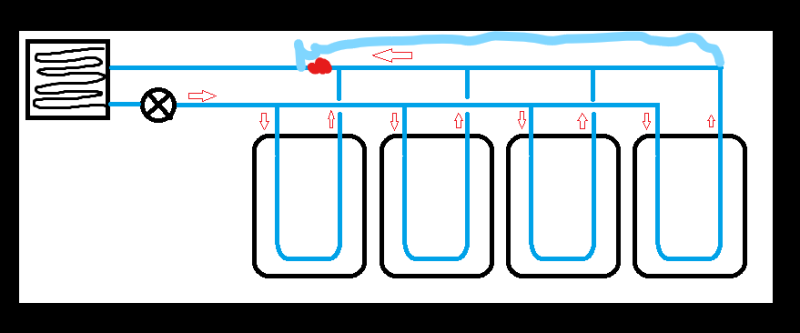jsenff
Mechanical
- Sep 4, 2017
- 3
Good morning all,
I'm working on a task which is very much not my area of expertise, and I was hoping you might have a few pointers.
I'm basically creating a rudimentary liquid cooling system, where a pump is supplying coolant through a pipe, which is split off into four liquid tanks, and I'm looking to make the flow through each tee as even as possible.
I've attached a crude mockup for illustration.
The pipes going into the tanks are MDPE SDR11 (material constraints) 25mm OD 20mm ID, and roughly 20-25m in length. The total flow rate from the pump is to be 100 litre/minute with each tank ideally receiving 25 litre/minute.
The distance between the pump and the final tank is ~30ft. I have scope to constrain things further as needed, but at the moment they're quite open ended.
Any advice on where to start would be greatly appreciated, as well as any general design advice. Would I be best using straight tees, or 45° angled tees?
Thanks in advance for your time.
I'm working on a task which is very much not my area of expertise, and I was hoping you might have a few pointers.
I'm basically creating a rudimentary liquid cooling system, where a pump is supplying coolant through a pipe, which is split off into four liquid tanks, and I'm looking to make the flow through each tee as even as possible.
I've attached a crude mockup for illustration.
The pipes going into the tanks are MDPE SDR11 (material constraints) 25mm OD 20mm ID, and roughly 20-25m in length. The total flow rate from the pump is to be 100 litre/minute with each tank ideally receiving 25 litre/minute.
The distance between the pump and the final tank is ~30ft. I have scope to constrain things further as needed, but at the moment they're quite open ended.
Any advice on where to start would be greatly appreciated, as well as any general design advice. Would I be best using straight tees, or 45° angled tees?
Thanks in advance for your time.

